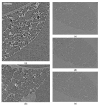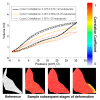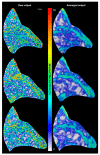Correlating Local Volumetric Tissue Strains with Global Lung Mechanics Measurements
- PMID: 33477444
- PMCID: PMC7829924
- DOI: 10.3390/ma14020439
Correlating Local Volumetric Tissue Strains with Global Lung Mechanics Measurements
Abstract
The mechanics of breathing is a fascinating and vital process. The lung has complexities and subtle heterogeneities in structure across length scales that influence mechanics and function. This study establishes an experimental pipeline for capturing alveolar deformations during a respiratory cycle using synchrotron radiation micro-computed tomography (SR-micro-CT). Rodent lungs were mechanically ventilated and imaged at various time points during the respiratory cycle. Pressure-Volume (P-V) characteristics were recorded to capture any changes in overall lung mechanical behaviour during the experiment. A sequence of tomograms was collected from the lungs within the intact thoracic cavity. Digital volume correlation (DVC) was used to compute the three-dimensional strain field at the alveolar level from the time sequence of reconstructed tomograms. Regional differences in ventilation were highlighted during the respiratory cycle, relating the local strains within the lung tissue to the global ventilation measurements. Strains locally reached approximately 150% compared to the averaged regional deformations of approximately 80-100%. Redistribution of air within the lungs was observed during cycling. Regions which were relatively poorly ventilated (low deformations compared to its neighbouring region) were deforming more uniformly at later stages of the experiment (consistent with its neighbouring region). Such heterogenous phenomena are common in everyday breathing. In pathological lungs, some of these non-uniformities in deformation behaviour can become exaggerated, leading to poor function or further damage. The technique presented can help characterize the multiscale biomechanical nature of a given pathology to improve patient management strategies, considering both the local and global lung mechanics.
Keywords: alveoli; digital volume correlation; lung mechanics; micro-CT; synchrotron.
Conflict of interest statement
The authors declare no conflict of interest. The funders had no role in the design of the study; in the collection, analyses, or interpretation of data; in the writing of the manuscript; or in the decision to publish the results.
Figures








References
-
- Xiao Q., Cetto R., Doorly D., Bates A.J., Rose J.N., McIntyre C., Comerford A., Madani G., Tolley N.S., Schroter R. Assessing Changes in Airflow and Energy Loss in a Progressive Tracheal Compression Before and After Surgical Correction. Ann. Biomed. Eng. 2020;48:822–833. doi: 10.1007/s10439-019-02410-1. - DOI - PMC - PubMed
Grants and funding
LinkOut - more resources
Full Text Sources
Other Literature Sources
Research Materials

